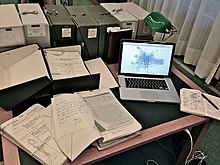
An academic conference is basically a gathering of researchers in the same field of study. In this gathering, they present the findings of their research study and get themselves updated with the latest innovations in their field. An academic conference has different names, such as academic congress, research conference, academic meeting, and symposium.
These conferences are usually organized by companies or academic societies of independent scholars. However, every academic conference is monitored by a scientific committee that reviews the quality of papers submitted to the conference.
Academic conferences are not just restricted to people in academia. They can be either small meetings held for local scientists or large global events that include the participation of thousands of international scientists.
An academic conference may include highly-specific topics restricted to a particular discipline or it may be an interdisciplinary conference that presents perspectives of academics from related fields. Industry professionals from different disciplines may also be invited to attend academic conferences.
The content of most academic conferences is intellectually stimulating, so researchers should always make it a point to attend such conferences. Young researchers get acquainted with research happening outside their field of study.
It is an excellent platform to socialize with researchers outside your field of specialization. Thus, you can build long-lasting relations with new researchers and increase the possibility of international collaborations. However, many people still do not know the list of benefits an academic conference can offer.
Most people working in industry attend professional conferences to get acquainted with industry trends and market summary. On the other hand, academic conferences are based on a totally different wavelength.
Usually, academic conferences are filled with abstract presentation, keynote speakers, innovative research studies, and poster presentations. To ease the anxiety of researchers attending an academic conference for the first time, let’s dig into the world of academic conferences.
How is an academic conference conducted for researchers?
Because academic conferences serve as a platform for presenting the most innovative research studies in a field of study, academics come across latest developments in their field of specialization. This means that participants who attend such conference also get a chance to present their work to a wider audience.
An academic conference is lined up with a list of short presentations that captivate the attention of the audience. In some large conference, organizers may arrange “parallel sessions” that run simultaneously through the conference.
With the evolution of academic publishing, the format of academic conferences has also undergone transformations. Because industrial conferences have gained immense popularity among professionals, academic conference has also become a bit more flexible in their selection process.
Now-a-days, academic conference have also become interactive and include debate sessions to engage the attention of participants. Nevertheless, most academic presentations can be classified in the following categories:
Plenary sessions: In most academic conferences, papers are accepted from parallel streams. However, all participants are requested to attend the plenary session. A plenary session includes a keynote session, different types of presentations or panels.
Keynote session: Most delegates are attracted to the keynote session of an academic conference. In this session, keynote speakers present the scope of the entire conference and encourage the collective endeavor of academics participating in the conference.
Panel sessions: A particular topic is selected for debate and discussion in the academic conference. Panelist are invited to moderate the debate of multiple researchers. They can issue statements or simply answer questions put forth from the audience. The goal of panel sessions is to facilitate the exchange of viewpoints presented by experts on a particular topic.
Oral sessions: In this session, several presenters give a small talk on their selected papers, which are based on a common theme. Every presenter has to complete their speech within a short duration of time, usually 10 minutes. After each presentation, additional time is allotted for a quick question-and-answer session with the audience.
Poster sessions: Physical or digital posters of researchers are usually displayed in the conference hall filled with academics. These posters are displayed for a long time and at the same platform in the conference room. There are no time constraints observed for poster sessions. The conference delegates take their own time to peruse through different posters and they then discuss the presented research work with the authors.
Workshops: Most academic conferences have lectures, tutorials, and workshops on following subjects: science communication, how ESL researchers can get their work published in international English journals. Most graduate students and young researchers benefit a lot by attending such workshops. This is because they are in the nascent stage of their research careers and are not really adept at scientific writing. By attending such writing workshops, they can really understand the complexity of academic publishing.
Harrisco is a top academic editing company that organizes academic conferences on various topics. All conference papers are published as proceedings by Harrisco. A few of the selected papers of high-quality are published completed in our selected SCI journals. Harrisco has been in the business of academic conference since 2017. Its latest conference is scheduled to be held in August. The conference website is www.iknc.org
The reviewing committee has strict selection standards to ensure that our conference are aimed at the scientific community of international repute. Harrisco edits all selected papers prior to publication in academic journals. The academic conferences have prestigious keynote speakers from reputed institutions across the world. Come, let’s explore the world of academic conferences. Let’s build the future of our budding researchers.



